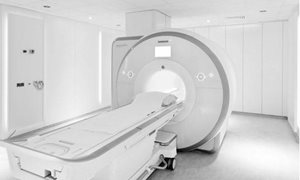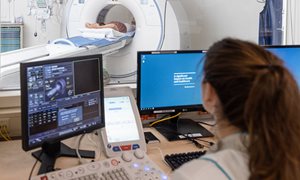What is NANO MRI?
NANO MRI is an examination in which a new contrast agent (Combidex) is used. read moreWhat is NANO MRI?
NANO MRI is an examination in which a new contrast agent (Combidex) is used. This contrast agent is a fluid containing very small iron particles which is administered via an intravenous line. After 24 hours the iron particles are found in healthy lymph nodes. When an MRI scan is made, the healthy lymph nodes which contain the iron particles, show up black in the images. Unhealthy (metastases) lymph nodes show up white (no up-take of the iron particles). With this technique, even the smallest metastases are visible.
The examination
Special preparation
Because we are examining your prostate, some additional preparations should be made.
read more
During the examination
The MRI NANO procedure is carried out over 2 days. On day 1 the ‘NANO’ contrast agent (Combidex) will be administered and on day 2 the MRI will take place. read moreDuring the examination
You are required to report to the Radiology Department (Route 780) 10 minutes before the time stated on your appointment card or letter, keeping in mind that it’s a 10 minute walk from the main entrance to the Radiology Department.Please contact the Radiology Department if you have hemochromatosis (an iron storage disorder) as you may not receive this contrast agent. The radiologist may consult your specialist for an alternative examination.
The MRI NANO procedure is carried out over 2 days. On day 1 the ‘NANO’ contrast agent (Combidex) will be administered and on day 2 the MRI will take place.
DAY 1: Contrast agent
On day 1 of the examination the ‘NANO’ contrast agent will be administered 24-36 hours before the MRI scan. In your appointment letter or email you can find time and place of your appointment. The radiographer or assistant will collect you (and your companion) from the waiting area and bring you to the preparation room. An intravenous line will be installed. Followed by a slow drip infusion of the contrast agent by the radiologistor his/her assistant. The whole infusion process takes approximately 60 minutes.NOTE: Please contact the Radiology Department if you have hemochromatosis (an iron storage disorder) as you may not receive this contrast agent. The radiologist may consult your specialist for an alternative examination.
As with all medical procedures, the NANO contrast agent can occasionally lead to side-effects. Possible side-effects of the NANO contrast agent are tremors, headaches, abdominal pains, nausea, back pain, chest pain, chest tightness, redness, skin irritation or blemishes e.g. itching and a rash during or directly after the injection. In most cases these reactions disappear spontaneously without requiring anyfurther treatment.
Should you have had a reaction to a contrast agent in the past, please contact the Radiology Department as the radiologist can consult with your specialist and take preventative measures.
DAY 2: MRI NANO
You are required to report to the Radiology Department (Route 780) 10 minutes before the time stated on your appointment card or letter. When you check in at the Radiology Department, your details will be verified and corrected if necessary.In case you did forget to bring your ´check list´ then you will be required to fill out a new one. You will then be directed to the correct waiting area where the radiographer or assistant will collect you (and your companion) and bring you to a changing room where you (and your companion) will be required to leave all metal objects, telephones, credit-bank cards etc, behind.
To facilitate sharper images is necessary to administer medications, Buscopan® and Glucagon®, to temporarily reduce movement of the bowels to facilitate sharper images. This is administered by the radiographer via the intravenous line and an intra-muscular injection in the upper leg, just before the start of the examination.
You may not receive these medications if you have:
- Increased eye-pressure (glaucoma);
- Increased or irregular heart rhythm;
- A muscle disease;
- Narrowing or obstruction of your large bowel;
- Problems with urinating, whereby you have to insert a catheter to empty the
- bladder;
- Diabetes;
- Use of blood thinning agents (anti-coagulants).
radiology department or ask the radiographer during the preparation for your
examination.
When you enter the MRI examination room, you will be asked to lie on the scanner
table. To detect the tiny radio signals that are emitted from the body, a ‘receiving device´ is placed behind or around the area to be examined. You are given the alarm-bell (rubber ball) and given earplugs or headphones to wear to protect your hearing from the very loud noises (knocking/buzzing) that you will hear during your examination. The examination table then slides into the scanner so that the part of your body being examined is positioned in the centre of the scanner (an open-ended, cylinder-shaped machine about a meter long). If you wish you may listen to the radio. During the examination many images are acquired, some taking a few seconds, others several minutes. Once one set of images have been acquired, there is a short pause before the onset of the following series. It is important that you lie very still during the whole procedure, which takes approximately 75 minutes.
After the examination
One of the possible side-effects of the medication Buscopan®, is that you may have blurred vision. This is only a short-term, temporary side-effect. lees meerAfter the examination
One of the possible side-effects of the medication Buscopan®, is that you may have blurred vision. This is only a short-term, temporary side-effect.One of the possible side-effects of Glugagon®, is that you may feel weak or dizzy after the MRI scan. We recommend that you bring some food for after the examination.
The results
The results of your MRI scan are not available immediately after the scan. A radiologist interprets the images and reports the findings to your specialist. You receive the results from your specialist at your next appointment. Please note that it takes at least a week before the results are known.More information
Your appointment
Your doctor will make an appointment. You will get a notification. If you are unable to attend, please let us know as soon as possible so that your appointment can be given to another patient.
lees meerYour appointment
Your doctor will make an appointment. You will get a notification.
Cancelling or changing your appointment
If you are unable to attend, please let us know as soon as possible so that your appointment can be given to another patient. You can call the Radiology Department on weekdays between 08.30-16.45 at (024) 361 45 29.
Should you wish to cancel your appointment we request that you also inform your specialist.
Getting there
Visiting address
Radboudumc main entrance
Geert Grooteplein Zuid 10
6525 GA Nijmegen
Directions




Department Imaging
The Imaging department examines and treats various conditions, and has three focus areas: anatomy, nuclear medicine and radiology.
go to page